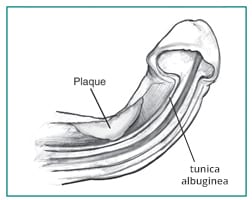Peyronie’s Disease Treatment
Peyronie’s disease can be found in up to 9% of men, most often occurring among men in their 50’s to 60’s but may occur in men of all ages.
Precision Sexual Health Clinic for Men offers treatments that can reduce penile curvature and pain, and provide significant quality-of-life benefits to men with Peyronie’s.
Peyronie’s disease treatments include shockwave therapy, penile injections, oral medications, topical therapies, penile traction devices, lifestyle modifications, and surgical procedures.
What is Peyronie’s Disease?
Peyronie’s disease is an acquired penile deformity (curvature) due to scar tissue in the penile shaft. This can cause penile pain and discomfort, can reduce or diminish the quality of erections, can complicate sexual intercourse, and can cause significant psychological burden for affected men and their sexual partners.
Peyronie’s is different from congenital penile curvature, as the latter is present since the time of birth, where Peyronie’s is acquired later in life. Some men will have penile pain associated with the onset of symptoms. Curvatures can range in severity from a slight bend to significant curves greater than 90 degrees.
Peyronie’s disease can be very distressing to both the man and their partner. In fact, among men completing depression questionnaires, nearly 50% meet the threshold for clinically meaningful depression, and just over 50% of men report relationship stress because of their Peyronie’s disease.
Progression of Peyronie’s Disease
Peyronie’s disease is variable among men. Based upon studies in the literature, we know that over the course of 1-year complete resolution of penile pain occurs in nearly 90% of men.
With respect to penile curvature, only 12% of men will report improvement over 1 year if left untreated, while 21-40% will report no change in symptoms and 48-76% will report worsening curvature.
In nearly all cases, treatment may reduce penile curvature and pain, and improve men’s sexual function.
- VIRTUALLY PAINLESS TREATMENT
What Causes Peyronie’s Disease?
The underlying cause for Peyronie’s is not known and is under investigation in doctor’s labs around the world. What is known, is that the cells present (i.e. fibroblasts) in the structural lining (i.e. tunica albuginea) of the erectile chambers (i.e. corpora cavernosa) function irregularly and produce abnormal amounts of collagen and fibrin leading to plaque formation.
Normally, when the penis changes from a soft/ flaccid state, to an erect state, a series of neurochemical reactions occur that result in more blood entering the penis than leaves. For this to occur, the smooth muscle in the penis must relax and expand, as does the tunica albuginea (lining of these erectile chambers).
However, the lining that has a Peyronie’s plaque cannot stretch and expand like the remaining normal penis; thus, as the erection expands in length, the non-expanding plaque causes that section to be shorter than the opposite side resulting in a curve. Similarly, as the penis expands in girth with an erection, the plaque fails to expand and stretch and may result in an indentation, narrowing or tapering. Peyronie’s may also lead to erectile dysfunction by preventing normal relaxation and trapping of blood in the penile chambers (i.e. corpora cavernosa) at the site of Peyronie’s plaque.

Making the Diagnosis
In most cases, based upon history and physical examination the doctor will be able to make the diagnosis. When the penis is flaccid, one may be able to palpate the ‘plaque’ or site of fibrosis on the penis; however, curvature to one’s penis and deformities can only accurately be assessed when the penis is erect.
When a patient is interested in pursuing treatment (i.e. the curve is both bothersome and functionally impairing), then the doctor will perform a penile curvature assessment where he or she will induce an erection with medication and perform a very detailed assessment of the abnormalities as well as ultrasound assessment of the plaque.
the Precision program
Leverage advanced methods and techniques for your patients.
Peyronie’s Treatments at Precision Clinics
ED is a treatable condition and most men are able to return to healthy sexual function with a course of treatment at Precision Sexual Health Clinic for Men.
The sooner treatment is begun, the more options available and the better results you are likely to get. The aim of most treatments is to stop the disease progressing further, maintain or improve sexual function, relieve any penile pain and to straighten the bend as much as possible.
Precision franchised clinics will offer multiple complementary Peyronie’s disease treatments, and this results in a good success rate and is an important differentiation from competing providers. Our set of complementary therapies permit us to get results even when some treatments are less effective than others.
Multiple treatments are recommended, and can include:
Shockwave Therapy (using our distinctive shockwave head specialized for Peyronie’s)
Low Intensity Shock Wave Therapy (LiSWT) has been shown to be an effective treatment modality for relieving the pain associated with Peyronie’s disease as well as vasculogenic erectile dysfunction.
The actual mechanism of LiSWT for Peyronie’s disease is not fully understood. However, electron microscopy studies have demonstrated actual histological changes within the Peyronie’s plaque following LiSWT.
Additional studies also reported an improvement in penile curvature by more than 15° in 33% of men who received LiSWT with a corresponding decrease in penile plaque hardness in 60%. LiSWT is believed to reduce the pain associated with Peyronie’s disease and to improve the quality of erection by promoting the generation of new and stronger blood vessels at the level of the penile shaft.
Topical Verapamil
Verapamil gel, a topical version of the drug, has also been effective in eliminating pain upon erection, decreasing the size of plaque, decreasing curvature, and improving erection quality in patients with Peyronie’s disease.
It is a prescription compounded medication that is applied directly to the skin. Verapamil belongs to the class of medications known as calcium channel blockers. The gel has been designed to carry the verapamil through the skin and deliver it to the Peyronie’s plaque. The proprietary formula allows for minimal absorption into the blood, while maximizing the concentration of verapamil in the plaque and surrounding tissue.
Trimix Injections After Shockwave Therapy
Oral Medications
Pentoxifylline
Pentoxifylline belongs to a group of drugs which improve peripheral blood flow and thus enhance peripheral tissue oxygenation. This medication also has strong antioxidant, anti-inflammatory effects. Additionally, Pentoxifylline has fibrinogen-reducing properties which can help decrease the Peyronie’s plaque and prevent advancement when in the acute stage. It can be taken orally, and also may be administered as an intralesional injection.
Coenzyme Q10
Coenzyme Q10 is an antioxidant and anti-inflammatory medicine. Coenzyme Q10 supplementation may lead the decrease of plaque volume and penile curvature and improved erectile function in patients with early chronic Peyronie’s disease.
PDE-5 Inhibitors
PDE-5 inhibitors, often prescribed for erectile dysfunction, are sometimes beneficial for patients in the early stages of Peyronie’s disease. In a study of Peyronie’s’ patients the drug was associated with decreased pain on erection and degree of penile curvature, and improved erectile function.
Vitamin E
The proposed action of vitamin E for Peyronie’s is through its ability to scavenge free radicals. Many clinicians consider this inexpensive, virtually side effect-free drug a reasonable treatment to offer patients awaiting stabilization of disease.
Penile Intralesional Injections
Pentoxifylline
Pentoxifylline belongs to a group of drugs which improve peripheral blood flow and thus enhance peripheral tissue oxygenation. It can be used as an intralesional injection, as well as in oral form.
This medication also has strong antioxidant, anti-inflammatory effects. Additionally, Pentoxifylline has fibrinogen-reducing properties which can help decrease the Peyronie’s plaque and prevent advancement when in the acute stage.
Xiaflex
Xiaflex is injected into the plaque in your penis which may help break down the plaque that is causing your erect penis to curve. This may help the erection to be straighter and may enable you to feel less bothered by your Peyronie’s disease. The active substance is collagenase clostridium histolyticum and is naturally produced by a bacterium named Clostridium histolyticum.
Interferon
Interferon injections appear to disrupt the production of fibrous tissue and help break it down. It also has been shown to reduce penile pain in men with Peyronie’s disease.
Mechanical Techniques
Surgical Therapies
For men that are not candidates for other forms of therapy and are both psychologically and functionally bothered by their Peyronie’s Disease, surgery may be an option. This may include different techniques depending upon the nature of the curve, deformity, and baseline erectile function. The doctor will discuss these if they are appropriate but generally include:
- Penile plication – shortening the ‘long side of the penis’ opposite the curve.
- Penile plaque excision and grafting – the scar tissue is cut and stretched, and a graft is sewn in place.
- Penile implant device that replaces the erectile tissue and helps to straighten the penis (typically reserved for men with significant curvature and erectile dysfunction).
Lifestyle Modifications
Patients should do everything they can to improve their vascular and aerobic health. Exercise is very important as is a good diet.
Lifestyle changes may allow a man to achieve an erection more easily, allowing him to continue having sex, even when he has Peyronie’s disease. Some of the potential lifestyle changes a man can try include:
- Quitting smoking
- Exercising regularly
- Reducing the consumption of alcohol
- Eliminating the use of illegal drugs
A man may also want to undergo counselling to help with stress, anxiety, or depression. Understand that these lifestyle changes may not affect Peyronie’s disease. Changes of this kind are intended to improve the ability to have sexual intercourse without worrying about ED symptoms.

What does a physician receive with the Precision program?
Training
The core or our program is the world-class training on the treatments and procedures. Our unique and innovative treatment protocols will be taught to you one-on-one by an experienced physician.
Marketing Expertise
Even before you start training, your marketing program will be underway – starting with market research to determine an optimal web marketing and pricing strategy for your clinic.
Web Marketing
You will experience an exceptional service level with our approved web marketing vendor. Your online investment will generate a positive ROI very quickly and is a key driver to a fast ramp-up of your business.